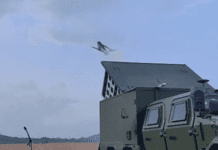This post is also available in:
 עברית (Hebrew)
עברית (Hebrew)
Snakelike, limbless robots would be extremely useful in search-and-rescue situations where they could navigate collapsed buildings to find and assist survivors, easily moving through spaces where walking or wheeled robots and human rescuers struggle. Scientists have been attempting to create this type of robot for decades, but all attempts did not have the free movement and agility of worms and snakes in difficult terrain.
A team of roboticists and physicists from the Georgia Institute of Technology set out to solve this mystery by turning to biomechanics, building a robot model that drives its body using a mechanism similar to how worms and snakes power their movement.
According to Techxplore, engineers so far tried designing algorithms for robots that take in information from sensors on the robot’s body and use that information to decide how to move using complex algorithms and systems. The team aimed to simplify these systems by focusing on mechanically controlled approaches to dealing with obstacles that don’t require sensors or computation.
The researchers did so by turning to examples from biology. They found that animals use a combination of their neural networks and the physical properties of their body to control movement. For example, the elasticity of muscles causes worms to react to their environment spontaneously before their neurons even have a chance to respond.
The scientists took inspiration from actual limbless animals and designed an algorithm in addition to a carefully crafted a physical system. In addition to having sensors on the robot’s head and tail, the scientists selected the robot’s materials and the arrangement and strength of its motors so that collisions would spontaneously produce a body shape that led to a turn – having what scientists call “mechanical intelligence.”
Another aspect of this innovation came from looking at how limbless organisms move- the researchers discovered that these animals achieve bends not from a single rotational joint-motor system but instead through two bands of muscles on either side of the body.
The team then created a new robot called MILLR (mechanically intelligent limbless robot) based on these two bands of muscle on snakes and worms. It has two independently controlled cables that pull each joint left and right, bilaterally. They then discovered that this method allows the robot to spontaneously move around obstacles without having to sense its surroundings and actively change its body posture to comply with the environment.
To test MILLR, the scientists built a tiny obstacle course and had both real worms and MILLR go through it. When comparing the results, they discovered that MILLR moved about as effectively as the real worms, and that the worms made the same type of body movements when they collided with obstacles as MILLR did.
The principles of this discovery could extend beyond the realm of nematodes and be used to create robots for applications ranging from search and rescue to exploring other planets.


























